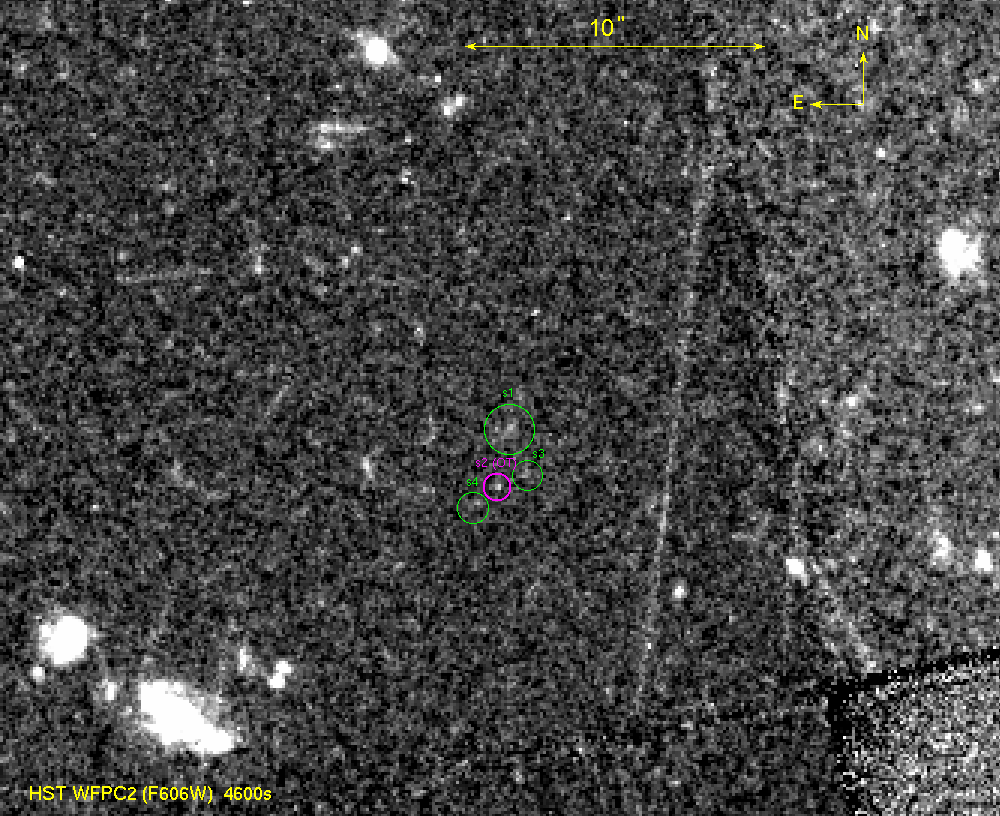(All information courtesy of the instrument teams.)
![]() Previous IAU Circulars
Previous IAU Circulars
TITLE: GCN/SWIFT NOTICE
NOTICE_DATE: Sat 03 May 08 12:26:29 UT
NOTICE_TYPE: Swift-BAT GRB Position
TRIGGER_NUM: 310785, Seg_Num: 0
GRB_RA: 286.617d {+19h 06m 28s} (J2000),
286.609d {+19h 06m 26s} (current),
286.662d {+19h 06m 39s} (1950)
GRB_DEC: +68.778d {+68d 46' 41"} (J2000),
+68.791d {+68d 47' 29"} (current),
+68.698d {+68d 41' 54"} (1950)
GRB_ERROR: 3.00 [arcmin radius, statistical only]
GRB_INTEN: 558 [cnts] Image_Peak=75 [image_cnts]
TRIGGER_DUR: 0.064 [sec]
TRIGGER_INDEX: 10418 E_range: 25-100 keV
BKG_INTEN: 29386 [cnts]
BKG_TIME: 44757.23 SOD {12:25:57.23} UT
BKG_DUR: 8 [sec]
GRB_DATE: 14589 TJD; 124 DOY; 08/05/03
GRB_TIME: 44773.23 SOD {12:26:13.23} UT
GRB_PHI: -6.72 [deg]
GRB_THETA: 32.33 [deg]
SOLN_STATUS: 0x3
RATE_SIGNIF: 20.19 [sigma]
IMAGE_SIGNIF: 8.79 [sigma]
MERIT_PARAMS: +1 +0 +0 -2 +2 +8 +0 +0 -11 +1
SUN_POSTN: 40.98d {+02h 43m 56s} +15.87d {+15d 52' 17"}
SUN_DIST: 83.61 [deg] Sun_angle= 7.6 [hr] (West of Sun)
MOON_POSTN: 12.80d {+00h 51m 11s} +9.75d {+09d 44' 45"}
MOON_DIST: 79.54 [deg]
MOON_ILLUM: 6 [%]
GAL_COORDS: 99.68, 23.83 [deg] galactic lon,lat of the burst (or transient)
ECL_COORDS: 26.92, 83.33 [deg] ecliptic lon,lat of the burst (or transient)
COMMENTS: SWIFT-BAT GRB Coordinates.
COMMENTS: This is a rate trigger.
COMMENTS: A point_source was found.
COMMENTS: This does not match any source in the on-board catalog.
COMMENTS: This does not match any source in the ground catalog.
COMMENTS: This is a GRB.
COMMENTS: This trigger occurred at longitude,latitude = 188.59,20.13 [deg].
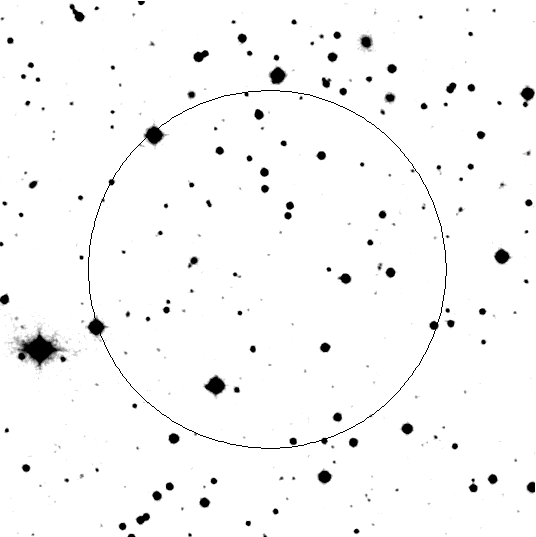
TITLE: GCN/SWIFT NOTICE
NOTICE_DATE: Sat 03 May 08 12:28:07 UT
NOTICE_TYPE: Swift-XRT Image
TRIGGER_NUM: 310785, Seg_Num: 0
GRB_RA: 286.6174d {+19h 06m 28.1s} (J2000),
286.6095d {+19h 06m 26.2s} (current),
286.6629d {+19h 06m 39.1s} (1950)
GRB_DEC: +68.7934d {+68d 47' 36.2"} (J2000),
+68.8067d {+68d 48' 24.0"} (current),
+68.7137d {+68d 42' 49.2"} (1950)
GRB_ERROR: 4.7 [arcsec, radius, statistical plus systematic]
GRB_INTEN: 163 [cnts]
IMG_START_DATE: 14589 TJD; 124 DOY; 08/05/03
IMG_START_TIME: 44848.13 SOD {12:27:28.13} UT, 74.9 [sec] since BAT Trigger Time
CENTROID_X: 298.01, raw= 298 [pixels]
CENTROID_Y: 318.30, raw= 318 [pixels]
ROLL: 61.87 [deg]
GAIN: 2
MODE: 3, Long Image mode
WAVEFORM: 134
EXPO_TIME: 2.50 [sec]
GRB_POS_XRT_Y: 47.87
GRB_POS_XRT_Z: -10.09
IMAGE_URL: sw00310785000msxps_rw.img
SUN_POSTN: 40.98d {+02h 43m 56s} +15.87d {+15d 52' 18"}
SUN_DIST: 83.60 [deg] Sun_angle= 7.6 [hr] (West of Sun)
MOON_POSTN: 12.81d {+00h 51m 15s} +9.75d {+09d 45' 11"}
MOON_DIST: 79.54 [deg]
MOON_ILLUM: 6 [%]
GAL_COORDS: 99.69, 23.83 [deg] galactic lon,lat of the burst
ECL_COORDS: 27.05, 83.33 [deg] ecliptic lon,lat of the burst
COMMENTS: SWIFT-XRT Image.

TITLE: GCN/SWIFT NOTICE
NOTICE_DATE: Sat 03 May 08 12:28:13 UT
NOTICE_TYPE: Swift-XRT Processed Image
TRIGGER_NUM: 310785, Seg_Num: 0
GRB_RA: 286.6174d {+19h 06m 28.1s} (J2000),
286.6095d {+19h 06m 26.2s} (current),
286.6629d {+19h 06m 39.1s} (1950)
GRB_DEC: +68.7934d {+68d 47' 36.2"} (J2000),
+68.8067d {+68d 48' 24.0"} (current),
+68.7137d {+68d 42' 49.2"} (1950)
GRB_ERROR: 4.7 [arcsec, radius, statistical plus systematic]
GRB_INTEN: 163 [cnts]
IMG_START_DATE: 14589 TJD; 124 DOY; 08/05/03
IMG_START_TIME: 44848.13 SOD {12:27:28.13} UT, 74.9 [sec] since BAT Trigger Time
CENTROID_X: 298.01, raw= 298 [pixels]
CENTROID_Y: 318.30, raw= 318 [pixels]
ROLL: 61.87 [deg]
GAIN: 2
MODE: 3, Long Image mode
WAVEFORM: 134
EXPO_TIME: 2.50 [sec]
GRB_POS_XRT_Y: 47.87
GRB_POS_XRT_Z: -10.09
IMAGE_URL: sw00310785000msxps_rw.img
SUN_POSTN: 40.98d {+02h 43m 56s} +15.87d {+15d 52' 18"}
SUN_DIST: 83.60 [deg] Sun_angle= 7.6 [hr] (West of Sun)
MOON_POSTN: 12.81d {+00h 51m 15s} +9.75d {+09d 45' 13"}
MOON_DIST: 79.54 [deg]
MOON_ILLUM: 6 [%]
GAL_COORDS: 99.69, 23.83 [deg] galactic lon,lat of the burst
ECL_COORDS: 27.05, 83.33 [deg] ecliptic lon,lat of the burst
COMMENTS: SWIFT-XRT Processed Image.

TITLE: GCN/SWIFT NOTICE
NOTICE_DATE: Sat 03 May 08 12:27:57 UT
NOTICE_TYPE: Swift-XRT Position
TRIGGER_NUM: 310785, Seg_Num: 0
GRB_RA: 286.6174d {+19h 06m 28.1s} (J2000),
286.6095d {+19h 06m 26.2s} (current),
286.6629d {+19h 06m 39.1s} (1950)
GRB_DEC: +68.7934d {+68d 47' 36.2"} (J2000),
+68.8067d {+68d 48' 24.0"} (current),
+68.7137d {+68d 42' 49.2"} (1950)
GRB_ERROR: 4.7 [arcsec radius, statistical plus systematic, 90% containment]
GRB_INTEN: 7.82e-09 [erg/cm2/sec]
GRB_SIGNIF: 12.76 [sigma]
IMG_START_DATE: 14589 TJD; 124 DOY; 08/05/03
IMG_START_TIME: 44848.13 SOD {12:27:28.13} UT, 74.9 [sec] since BAT Trigger Time
TAM[0-3]: 327.66 237.25 261.41 243.52
AMPLIFIER: 2
WAVEFORM: 134
SUN_POSTN: 40.98d {+02h 43m 56s} +15.87d {+15d 52' 18"}
SUN_DIST: 83.60 [deg] Sun_angle= 7.6 [hr] (West of Sun)
MOON_POSTN: 12.81d {+00h 51m 15s} +9.75d {+09d 45' 08"}
MOON_DIST: 79.54 [deg]
MOON_ILLUM: 6 [%]
GAL_COORDS: 99.69, 23.83 [deg] galactic lon,lat of the burst
ECL_COORDS: 27.05, 83.33 [deg] ecliptic lon,lat of the burst
COMMENTS: SWIFT-XRT Coordinates.
COMMENTS: The XRT position is 0.92 arcmin from the BAT position.
COMMENTS: The object found at this position is either a very bright burst or a cosmic ray hit.
COMMENTS: Examine the XRT Image to differentiate (CRs are much more compact); see examples at:
COMMENTS: http://www.swift.psu.edu/xrt/XRT_Postage_Stamp_Image_Photo_Gallery.htm .
TITLE: GCN/SWIFT NOTICE
NOTICE_DATE: Sat 03 May 08 12:29:42 UT
NOTICE_TYPE: Swift-UVOT Source List
TRIGGER_NUM: 310785, Seg_Num: 0
POINT_RA: 286.628d {+19h 06m 31s} (J2000)
POINT_DEC: +68.779d {+68d 46' 46"} (J2000)
POINT_ROLL: 61.872d
IMG_START_DATE: 14589 TJD; 124 DOY; 08/05/03
IMG_START_TIME: 44856.88 SOD {12:27:36.88} UT, 83.6 [sec] since BAT Trigger Time
FILTER: 10, White
BKG_MEAN: 1.128
N_STARS: 74
X_OFFSET: 454 [pixels]
Y_OFFSET: 584 [pixels]
X_MAX: 1413 [pixels]
Y_MAX: 1543 [pixels]
DET_THRESH: 9
PHOTO_THRESH: 4
SL_URL: sw00310785000msufc0083.fits
SUN_POSTN: 40.98d {+02h 43m 56s} +15.87d {+15d 52' 19"}
SUN_DIST: 83.60 [deg] Sun_angle= 7.6 [hr] (West of Sun)
MOON_POSTN: 12.83d {+00h 51m 18s} +9.76d {+09d 45' 36"}
MOON_DIST: 79.54 [deg]
MOON_ILLUM: 6 [%]
GAL_COORDS: 99.68, 23.82 [deg] galactic lon,lat of the pointing direction
ECL_COORDS: 26.92, 83.33 [deg] ecliptic lon,lat of the pointing direction
COMMENTS: SWIFT-UVOT Source List.
TITLE: GCN/SWIFT NOTICE
NOTICE_DATE: Sat 03 May 08 12:30:22 UT
NOTICE_TYPE: Swift-UVOT Processed Source List
TRIGGER_NUM: 310785, Seg_Num: 0
POINT_RA: 286.628d {+19h 06m 31s} (J2000)
POINT_DEC: +68.779d {+68d 46' 46"} (J2000)
POINT_ROLL: 61.872d
IMG_START_DATE: 14589 TJD; 124 DOY; 08/05/03
IMG_START_TIME: 44856.88 SOD {12:27:36.88} UT, 83.6 [sec] since BAT Trigger Time
FILTER: 10, White
BKG_MEAN: 1.128
N_STARS: 74
X_OFFSET: 454 [pixels]
Y_OFFSET: 584 [pixels]
X_MAX: 1413 [pixels]
Y_MAX: 1543 [pixels]
DET_THRESH: 9
PHOTO_THRESH: 4
SL_URL: sw00310785000msufc0083.fits
SUN_POSTN: 40.98d {+02h 43m 56s} +15.87d {+15d 52' 20"}
SUN_DIST: 83.60 [deg] Sun_angle= 7.6 [hr] (West of Sun)
MOON_POSTN: 12.83d {+00h 51m 20s} +9.76d {+09d 45' 47"}
MOON_DIST: 79.53 [deg]
MOON_ILLUM: 6 [%]
GAL_COORDS: 99.68, 23.82 [deg] galactic lon,lat of the pointing direction
ECL_COORDS: 26.92, 83.33 [deg] ecliptic lon,lat of the pointing direction
COMMENTS: SWIFT-UVOT Processed Source List.
COMMENTS: All 4 attachments are included.
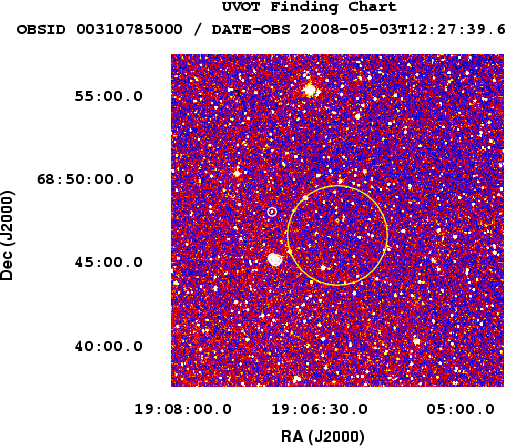
TITLE: GCN/SWIFT NOTICE
NOTICE_DATE: Sat 03 May 08 12:30:55 UT
NOTICE_TYPE: Swift-UVOT Image
TRIGGER_NUM: 310785, Seg_Num: 0
POINT_RA: 286.628d {+19h 06m 31s} (J2000)
POINT_DEC: +68.779d {+68d 46' 46"} (J2000)
ROLL: 61.872d
IMG_START_DATE: 14589 TJD; 124 DOY; 08/05/03
IMG_START_TIME: 44856.88 SOD {12:27:36.88} UT, 83.6 [sec] since BAT Trigger Time
FILTER: 10, White
EXPOSURE_ID: 231510459
X_OFFSET: 774 [pixels]
Y_OFFSET: 794 [pixels]
WIDTH: 160 [pixels]
HEIGHT: 160 [pixels]
X_GRB_POS: 934
Y_GRB_POS: 954
BINNING_INDEX: 1
IM_URL: sw00310785000msuni0083.fits
SUN_POSTN: 40.98d {+02h 43m 56s} +15.87d {+15d 52' 20"}
SUN_DIST: 83.60 [deg] Sun_angle= 7.6 [hr] (West of Sun)
MOON_POSTN: 12.84d {+00h 51m 21s} +9.77d {+09d 45' 56"}
MOON_DIST: 79.53 [deg]
MOON_ILLUM: 6 [%]
GAL_COORDS: 99.68, 23.82 [deg] galactic lon,lat of the pointing direction
ECL_COORDS: 26.92, 83.33 [deg] ecliptic lon,lat of the pointing direction
COMMENTS: SWIFT-UVOT Image.
COMMENTS: The GRB Position came from the XRT Position Command.
COMMENTS: The image has 2x2 binning (compression).
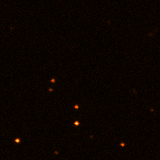
TITLE: GCN/SWIFT NOTICE
NOTICE_DATE: Sat 03 May 08 12:31:05 UT
NOTICE_TYPE: Swift-BAT GRB Lightcurve
TRIGGER_NUM: 310785, Seg_Num: 0
GRB_RA: 286.617d {+19h 06m 28s} (J2000),
286.609d {+19h 06m 26s} (current),
286.662d {+19h 06m 39s} (1950)
GRB_DEC: +68.778d {+68d 46' 41"} (J2000),
+68.791d {+68d 47' 29"} (current),
+68.698d {+68d 41' 54"} (1950)
GRB_DATE: 14589 TJD; 124 DOY; 08/05/03
GRB_TIME: 44773.42 SOD {12:26:13.42} UT
TRIGGER_INDEX: 10418
GRB_PHI: -6.72 [deg]
GRB_THETA: 32.33 [deg]
DELTA_TIME: -18.00 [sec]
TRIGGER_DUR: 0.064 [sec]
SOLN_STATUS: 0x3
RATE_SIGNIF: 20.19 [sigma]
IMAGE_SIGNIF: 8.79 [sigma]
LC_URL: sw00310785000msb.lc
SUN_POSTN: 40.98d {+02h 43m 56s} +15.87d {+15d 52' 20"}
SUN_DIST: 83.61 [deg] Sun_angle= 7.6 [hr] (West of Sun)
MOON_POSTN: 12.84d {+00h 51m 22s} +9.77d {+09d 45' 59"}
MOON_DIST: 79.54 [deg]
MOON_ILLUM: 6 [%]
GAL_COORDS: 99.68, 23.83 [deg] galactic lon,lat of the burst (or transient)
ECL_COORDS: 26.92, 83.33 [deg] ecliptic lon,lat of the burst (or transient)
COMMENTS: SWIFT-BAT GRB Lightcurve.
COMMENTS:
COMMENTS: The next comments were copied from the BAT_POS Notice:
COMMENTS: This is a rate trigger.
COMMENTS: A point_source was found.
COMMENTS: This does not match any source in the on-board catalog.
COMMENTS: This does not match any source in the ground catalog.
COMMENTS: This is a GRB.
COMMENTS: This trigger occurred at longitude,latitude = 188.59,20.13 [deg].
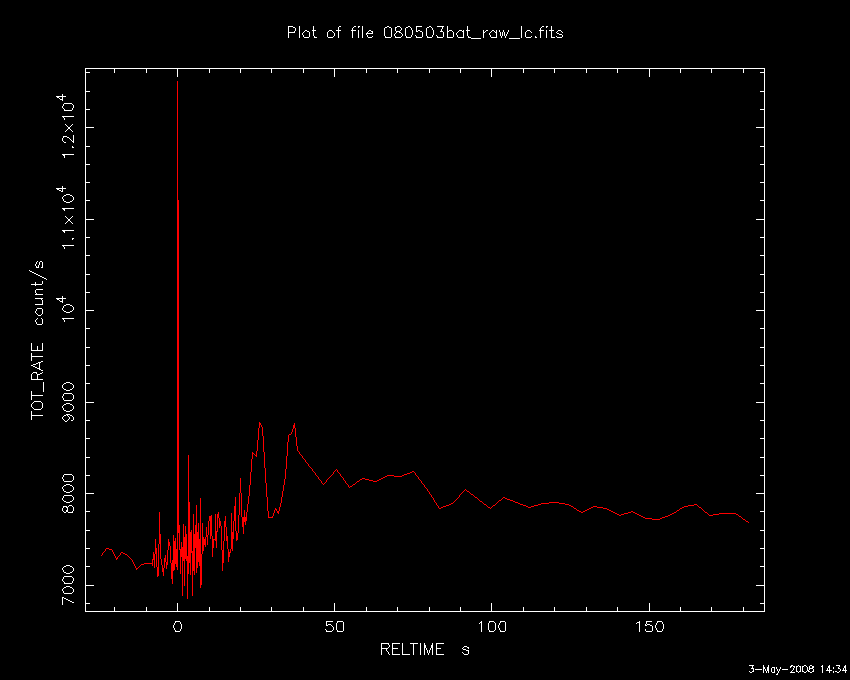
TITLE: GCN/SWIFT NOTICE
NOTICE_DATE: Sat 03 May 08 12:31:25 UT
NOTICE_TYPE: Swift-UVOT Processed Image
TRIGGER_NUM: 310785, Seg_Num: 0
POINT_RA: 286.628d {+19h 06m 31s} (J2000)
POINT_DEC: +68.779d {+68d 46' 46"} (J2000)
ROLL: 61.872d
IMG_START_DATE: 14589 TJD; 124 DOY; 08/05/03
IMG_START_TIME: 44856.88 SOD {12:27:36.88} UT, 83.6 [sec] since BAT Trigger Time
FILTER: 10, White
EXPOSURE_ID: 231510459
X_OFFSET: 774 [pixels]
Y_OFFSET: 794 [pixels]
WIDTH: 160 [pixels]
HEIGHT: 160 [pixels]
X_GRB_POS: 934
Y_GRB_POS: 954
BINNING_INDEX: 1
IM_URL: sw00310785000msuni0083.fits
SUN_POSTN: 40.98d {+02h 43m 56s} +15.87d {+15d 52' 21"}
SUN_DIST: 83.60 [deg] Sun_angle= 7.6 [hr] (West of Sun)
MOON_POSTN: 12.84d {+00h 51m 22s} +9.77d {+09d 46' 04"}
MOON_DIST: 79.53 [deg]
MOON_ILLUM: 6 [%]
GAL_COORDS: 99.68, 23.82 [deg] galactic lon,lat of the pointing direction
ECL_COORDS: 26.92, 83.33 [deg] ecliptic lon,lat of the pointing direction
COMMENTS: SWIFT-UVOT Processed Image.
COMMENTS: The GRB Position came from the XRT Position Command.
COMMENTS: The image has 2x2 binning (compression).
COMMENTS: If you have elected to receive attachments:
COMMENTS: The uvot_sources_image.fits.gz file does not exist; skipping the attachment.
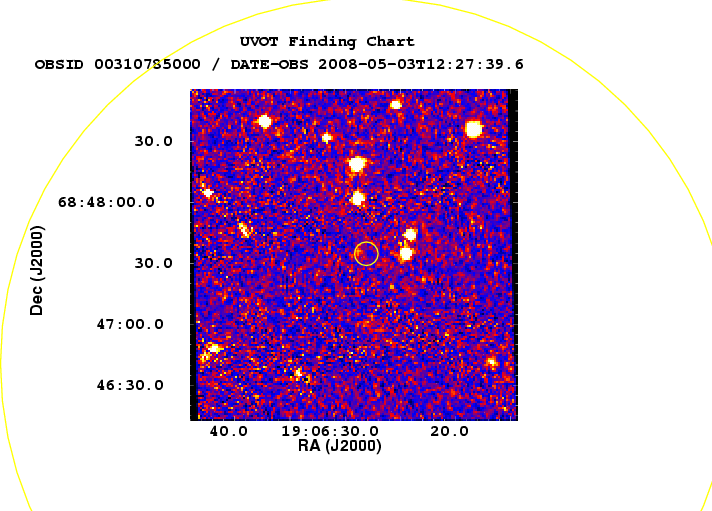
TITLE: GCN/SWIFT NOTICE
NOTICE_DATE: Sat 03 May 08 12:38:31 UT
NOTICE_TYPE: Swift-UVOT Source List
TRIGGER_NUM: 310785, Seg_Num: 0
POINT_RA: 286.626d {+19h 06m 30s} (J2000)
POINT_DEC: +68.782d {+68d 46' 56"} (J2000)
POINT_ROLL: 61.869d
IMG_START_DATE: 14589 TJD; 124 DOY; 08/05/03
IMG_START_TIME: 44962.88 SOD {12:29:22.88} UT, 189.6 [sec] since BAT Trigger Time
FILTER: 3, V
BKG_MEAN: 1.043
N_STARS: 120
X_OFFSET: 454 [pixels]
Y_OFFSET: 474 [pixels]
X_MAX: 1413 [pixels]
Y_MAX: 1433 [pixels]
DET_THRESH: 9
PHOTO_THRESH: 4
SL_URL: sw00310785000msufc0189.fits
SUN_POSTN: 40.99d {+02h 43m 57s} +15.87d {+15d 52' 26"}
SUN_DIST: 83.60 [deg] Sun_angle= 7.6 [hr] (West of Sun)
MOON_POSTN: 12.91d {+00h 51m 38s} +9.80d {+09d 47' 58"}
MOON_DIST: 79.53 [deg]
MOON_ILLUM: 6 [%]
GAL_COORDS: 99.68, 23.82 [deg] galactic lon,lat of the pointing direction
ECL_COORDS: 26.95, 83.33 [deg] ecliptic lon,lat of the pointing direction
COMMENTS: SWIFT-UVOT Source List.
TITLE: GCN/SWIFT NOTICE
NOTICE_DATE: Sat 03 May 08 12:39:05 UT
NOTICE_TYPE: Swift-UVOT Processed Source List
TRIGGER_NUM: 310785, Seg_Num: 0
POINT_RA: 286.626d {+19h 06m 30s} (J2000)
POINT_DEC: +68.782d {+68d 46' 56"} (J2000)
POINT_ROLL: 61.869d
IMG_START_DATE: 14589 TJD; 124 DOY; 08/05/03
IMG_START_TIME: 44962.88 SOD {12:29:22.88} UT, 189.6 [sec] since BAT Trigger Time
FILTER: 3, V
BKG_MEAN: 1.043
N_STARS: 120
X_OFFSET: 454 [pixels]
Y_OFFSET: 474 [pixels]
X_MAX: 1413 [pixels]
Y_MAX: 1433 [pixels]
DET_THRESH: 9
PHOTO_THRESH: 4
SL_URL: sw00310785000msufc0189.fits
SUN_POSTN: 40.99d {+02h 43m 58s} +15.87d {+15d 52' 26"}
SUN_DIST: 83.60 [deg] Sun_angle= 7.6 [hr] (West of Sun)
MOON_POSTN: 12.91d {+00h 51m 40s} +9.80d {+09d 48' 07"}
MOON_DIST: 79.53 [deg]
MOON_ILLUM: 6 [%]
GAL_COORDS: 99.68, 23.82 [deg] galactic lon,lat of the pointing direction
ECL_COORDS: 26.95, 83.33 [deg] ecliptic lon,lat of the pointing direction
COMMENTS: SWIFT-UVOT Processed Source List.
COMMENTS: All 4 attachments are included.
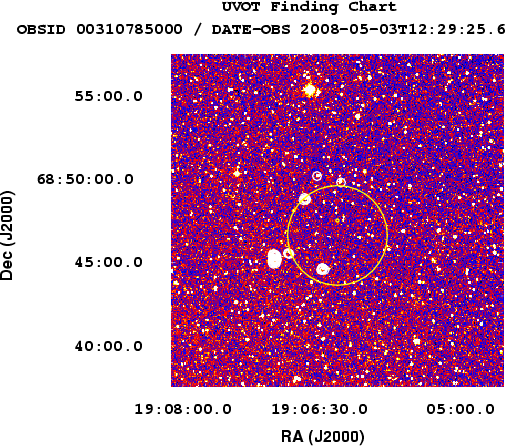
TITLE: GCN/SWIFT NOTICE
NOTICE_DATE: Sat 03 May 08 12:39:41 UT
NOTICE_TYPE: Swift-UVOT Image
TRIGGER_NUM: 310785, Seg_Num: 0
POINT_RA: 286.626d {+19h 06m 30s} (J2000)
POINT_DEC: +68.782d {+68d 46' 56"} (J2000)
ROLL: 61.869d
IMG_START_DATE: 14589 TJD; 124 DOY; 08/05/03
IMG_START_TIME: 44962.88 SOD {12:29:22.88} UT, 189.6 [sec] since BAT Trigger Time
FILTER: 3, V
EXPOSURE_ID: 231510565
X_OFFSET: 774 [pixels]
Y_OFFSET: 794 [pixels]
WIDTH: 160 [pixels]
HEIGHT: 160 [pixels]
X_GRB_POS: 934
Y_GRB_POS: 954
BINNING_INDEX: 1
IM_URL: sw00310785000msuni0189.fits
SUN_POSTN: 40.99d {+02h 43m 58s} +15.87d {+15d 52' 27"}
SUN_DIST: 83.60 [deg] Sun_angle= 7.6 [hr] (West of Sun)
MOON_POSTN: 12.92d {+00h 51m 41s} +9.80d {+09d 48' 17"}
MOON_DIST: 79.53 [deg]
MOON_ILLUM: 6 [%]
GAL_COORDS: 99.68, 23.82 [deg] galactic lon,lat of the pointing direction
ECL_COORDS: 26.95, 83.33 [deg] ecliptic lon,lat of the pointing direction
COMMENTS: SWIFT-UVOT Image.
COMMENTS: The GRB Position came from the XRT Position Command.
COMMENTS: The image has 2x2 binning (compression).
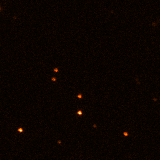
TITLE: GCN/SWIFT NOTICE
NOTICE_DATE: Sat 03 May 08 12:40:12 UT
NOTICE_TYPE: Swift-UVOT Processed Image
TRIGGER_NUM: 310785, Seg_Num: 0
POINT_RA: 286.626d {+19h 06m 30s} (J2000)
POINT_DEC: +68.782d {+68d 46' 56"} (J2000)
ROLL: 61.869d
IMG_START_DATE: 14589 TJD; 124 DOY; 08/05/03
IMG_START_TIME: 44962.88 SOD {12:29:22.88} UT, 189.6 [sec] since BAT Trigger Time
FILTER: 3, V
EXPOSURE_ID: 231510565
X_OFFSET: 774 [pixels]
Y_OFFSET: 794 [pixels]
WIDTH: 160 [pixels]
HEIGHT: 160 [pixels]
X_GRB_POS: 934
Y_GRB_POS: 954
BINNING_INDEX: 1
IM_URL: sw00310785000msuni0189.fits
SUN_POSTN: 40.99d {+02h 43m 58s} +15.87d {+15d 52' 27"}
SUN_DIST: 83.60 [deg] Sun_angle= 7.6 [hr] (West of Sun)
MOON_POSTN: 12.93d {+00h 51m 42s} +9.81d {+09d 48' 25"}
MOON_DIST: 79.53 [deg]
MOON_ILLUM: 6 [%]
GAL_COORDS: 99.68, 23.82 [deg] galactic lon,lat of the pointing direction
ECL_COORDS: 26.95, 83.33 [deg] ecliptic lon,lat of the pointing direction
COMMENTS: SWIFT-UVOT Processed Image.
COMMENTS: The GRB Position came from the XRT Position Command.
COMMENTS: The image has 2x2 binning (compression).
COMMENTS: If you have elected to receive attachments:
COMMENTS: The uvot_sources_image.fits.gz file does not exist; skipping the attachment.
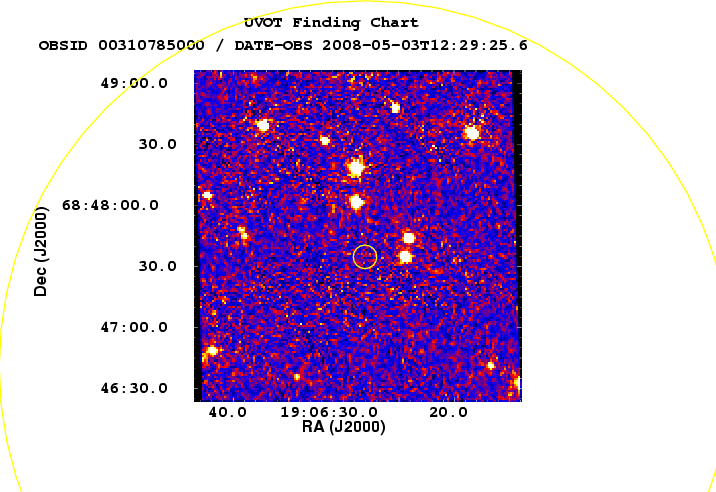
TITLE: GCN/SWIFT NOTICE
NOTICE_DATE: Sat 03 May 08 12:42:32 UT
NOTICE_TYPE: Swift-UVOT Source List
TRIGGER_NUM: 310785, Seg_Num: 0
POINT_RA: 286.626d {+19h 06m 30s} (J2000)
POINT_DEC: +68.782d {+68d 46' 56"} (J2000)
POINT_ROLL: 61.869d
IMG_START_DATE: 14589 TJD; 124 DOY; 08/05/03
IMG_START_TIME: 45626.35 SOD {12:40:26.35} UT, 853.1 [sec] since BAT Trigger Time
FILTER: 10, White
BKG_MEAN: 1.168
N_STARS: 93
X_OFFSET: 454 [pixels]
Y_OFFSET: 474 [pixels]
X_MAX: 1413 [pixels]
Y_MAX: 1433 [pixels]
DET_THRESH: 9
PHOTO_THRESH: 4
SL_URL: sw00310785000msufc0853.fits
SUN_POSTN: 40.99d {+02h 43m 58s} +15.87d {+15d 52' 29"}
SUN_DIST: 83.60 [deg] Sun_angle= 7.6 [hr] (West of Sun)
MOON_POSTN: 12.95d {+00h 51m 47s} +9.82d {+09d 49' 02"}
MOON_DIST: 79.53 [deg]
MOON_ILLUM: 6 [%]
GAL_COORDS: 99.68, 23.82 [deg] galactic lon,lat of the pointing direction
ECL_COORDS: 26.95, 83.33 [deg] ecliptic lon,lat of the pointing direction
COMMENTS: SWIFT-UVOT Source List.
TITLE: GCN/SWIFT NOTICE
NOTICE_DATE: Sat 03 May 08 12:43:11 UT
NOTICE_TYPE: Swift-UVOT Processed Source List
TRIGGER_NUM: 310785, Seg_Num: 0
POINT_RA: 286.626d {+19h 06m 30s} (J2000)
POINT_DEC: +68.782d {+68d 46' 56"} (J2000)
POINT_ROLL: 61.869d
IMG_START_DATE: 14589 TJD; 124 DOY; 08/05/03
IMG_START_TIME: 45626.35 SOD {12:40:26.35} UT, 853.1 [sec] since BAT Trigger Time
FILTER: 10, White
BKG_MEAN: 1.168
N_STARS: 93
X_OFFSET: 454 [pixels]
Y_OFFSET: 474 [pixels]
X_MAX: 1413 [pixels]
Y_MAX: 1433 [pixels]
DET_THRESH: 9
PHOTO_THRESH: 4
SL_URL: sw00310785000msufc0853.fits
SUN_POSTN: 40.99d {+02h 43m 58s} +15.87d {+15d 52' 29"}
SUN_DIST: 83.60 [deg] Sun_angle= 7.6 [hr] (West of Sun)
MOON_POSTN: 12.95d {+00h 51m 49s} +9.82d {+09d 49' 13"}
MOON_DIST: 79.53 [deg]
MOON_ILLUM: 6 [%]
GAL_COORDS: 99.68, 23.82 [deg] galactic lon,lat of the pointing direction
ECL_COORDS: 26.95, 83.33 [deg] ecliptic lon,lat of the pointing direction
COMMENTS: SWIFT-UVOT Processed Source List.
COMMENTS: All 4 attachments are included.
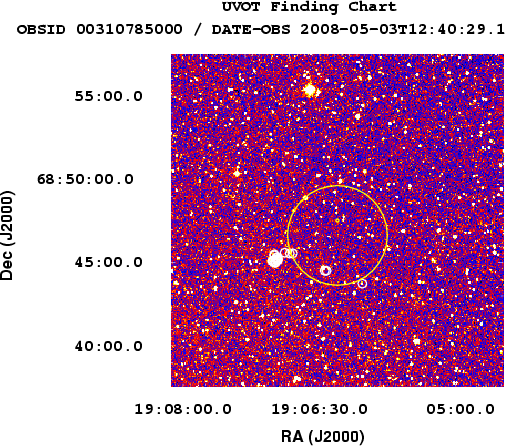
TITLE: GCN/SWIFT NOTICE
NOTICE_DATE: Sat 03 May 08 12:44:06 UT
NOTICE_TYPE: Swift-UVOT Processed Image
TRIGGER_NUM: 310785, Seg_Num: 0
POINT_RA: 286.626d {+19h 06m 30s} (J2000)
POINT_DEC: +68.782d {+68d 46' 56"} (J2000)
ROLL: 61.869d
IMG_START_DATE: 14589 TJD; 124 DOY; 08/05/03
IMG_START_TIME: 45626.35 SOD {12:40:26.35} UT, 853.1 [sec] since BAT Trigger Time
FILTER: 10, White
EXPOSURE_ID: 231511229
X_OFFSET: 773 [pixels]
Y_OFFSET: 793 [pixels]
WIDTH: 160 [pixels]
HEIGHT: 160 [pixels]
X_GRB_POS: 933
Y_GRB_POS: 953
BINNING_INDEX: 1
IM_URL: sw00310785000msuni0853.fits
SUN_POSTN: 40.99d {+02h 43m 58s} +15.87d {+15d 52' 30"}
SUN_DIST: 83.60 [deg] Sun_angle= 7.6 [hr] (West of Sun)
MOON_POSTN: 12.96d {+00h 51m 51s} +9.82d {+09d 49' 27"}
MOON_DIST: 79.53 [deg]
MOON_ILLUM: 6 [%]
GAL_COORDS: 99.68, 23.82 [deg] galactic lon,lat of the pointing direction
ECL_COORDS: 26.95, 83.33 [deg] ecliptic lon,lat of the pointing direction
COMMENTS: SWIFT-UVOT Processed Image.
COMMENTS: The GRB Position came from the Window Position in the Mode Command.
COMMENTS: The image has 2x2 binning (compression).
COMMENTS: If you have elected to receive attachments:
COMMENTS: The uvot_sources_image.fits.gz file does not exist; skipping the attachment.
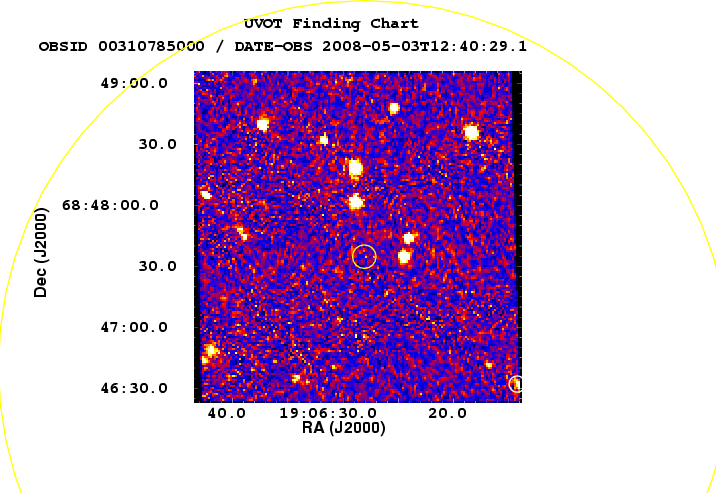
TITLE: GCN/SWIFT NOTICE
NOTICE_DATE: Sat 03 May 08 12:43:39 UT
NOTICE_TYPE: Swift-UVOT Image
TRIGGER_NUM: 310785, Seg_Num: 0
POINT_RA: 286.626d {+19h 06m 30s} (J2000)
POINT_DEC: +68.782d {+68d 46' 56"} (J2000)
ROLL: 61.869d
IMG_START_DATE: 14589 TJD; 124 DOY; 08/05/03
IMG_START_TIME: 45626.35 SOD {12:40:26.35} UT, 853.1 [sec] since BAT Trigger Time
FILTER: 10, White
EXPOSURE_ID: 231511229
X_OFFSET: 773 [pixels]
Y_OFFSET: 793 [pixels]
WIDTH: 160 [pixels]
HEIGHT: 160 [pixels]
X_GRB_POS: 933
Y_GRB_POS: 953
BINNING_INDEX: 1
IM_URL: sw00310785000msuni0853.fits
SUN_POSTN: 40.99d {+02h 43m 58s} +15.87d {+15d 52' 29"}
SUN_DIST: 83.60 [deg] Sun_angle= 7.6 [hr] (West of Sun)
MOON_POSTN: 12.96d {+00h 51m 50s} +9.82d {+09d 49' 20"}
MOON_DIST: 79.53 [deg]
MOON_ILLUM: 6 [%]
GAL_COORDS: 99.68, 23.82 [deg] galactic lon,lat of the pointing direction
ECL_COORDS: 26.95, 83.33 [deg] ecliptic lon,lat of the pointing direction
COMMENTS: SWIFT-UVOT Image.
COMMENTS: The GRB Position came from the Window Position in the Mode Command.
COMMENTS: The image has 2x2 binning (compression).
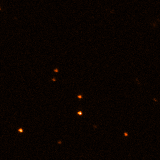
TITLE: GCN/SWIFT NOTICE
NOTICE_DATE: Sat 03 May 08 12:43:28 UT
NOTICE_TYPE: Swift-XRT Position UPDATE
TRIGGER_NUM: 310785, Seg_Num: 0
GRB_RA: 286.6204d {+19h 06m 28.8s} (J2000),
286.6125d {+19h 06m 27.0s} (current),
286.6659d {+19h 06m 39.8s} (1950)
GRB_DEC: +68.7937d {+68d 47' 37.3"} (J2000),
+68.8070d {+68d 48' 25.1"} (current),
+68.7140d {+68d 42' 50.2"} (1950)
GRB_ERROR: 2.5 [arcsec radius, statistical plus systematic, 90% containment]
GRB_INTEN: 1.00e-10 [erg/cm2/sec]
GRB_SIGNIF: 10.00 [sigma]
IMG_START_DATE: 14589 TJD; 124 DOY; 08/05/03
IMG_START_TIME: 45056.00 SOD {12:30:56.00} UT, 282.8 [sec] since BAT Trigger Time
TAM[0-3]: 100.00 100.00 100.00 100.00
AMPLIFIER: 1
WAVEFORM: 31
SUN_POSTN: 40.99d {+02h 43m 58s} +15.87d {+15d 52' 29"}
SUN_DIST: 83.60 [deg] Sun_angle= 7.6 [hr] (West of Sun)
MOON_POSTN: 12.96d {+00h 51m 49s} +9.82d {+09d 49' 17"}
MOON_DIST: 79.53 [deg]
MOON_ILLUM: 6 [%]
GAL_COORDS: 99.69, 23.83 [deg] galactic lon,lat of the burst
ECL_COORDS: 27.05, 83.33 [deg] ecliptic lon,lat of the burst
COMMENTS: SWIFT-XRT Coordinates.
COMMENTS: This Notice was ground-generated -- not flight-generated.
COMMENTS: This is an Update Notice -- the RA,Dec values herein supersede the previous XRT_POS Notice.
COMMENTS: TAM values, flux and significance fields are not valid
COMMENTS: This position was automatically generated on the ground using
COMMENTS: Photon Counting data telemetered via TDRSS (SPER data).
COMMENTS: See http://www.swift.ac.uk/sper/docs.php for details.
COMMENTS: This position was enhanced using UVOT field astrometry
TITLE: GCN/SWIFT NOTICE
NOTICE_DATE: Sat 03 May 08 12:49:14 UT
NOTICE_TYPE: Swift-UVOT Source List
TRIGGER_NUM: 310785, Seg_Num: 0
POINT_RA: 286.625d {+19h 06m 30s} (J2000)
POINT_DEC: +68.782d {+68d 46' 55"} (J2000)
POINT_ROLL: 61.869d
IMG_START_DATE: 14589 TJD; 124 DOY; 08/05/03
IMG_START_TIME: 45732.25 SOD {12:42:12.25} UT, 959.0 [sec] since BAT Trigger Time
FILTER: 3, V
BKG_MEAN: 1.288
N_STARS: 116
X_OFFSET: 454 [pixels]
Y_OFFSET: 474 [pixels]
X_MAX: 1413 [pixels]
Y_MAX: 1433 [pixels]
DET_THRESH: 10
PHOTO_THRESH: 5
SL_URL: sw00310785000msufc0959.fits
SUN_POSTN: 41.00d {+02h 43m 59s} +15.88d {+15d 52' 33"}
SUN_DIST: 83.60 [deg] Sun_angle= 7.6 [hr] (West of Sun)
MOON_POSTN: 13.01d {+00h 52m 02s} +9.85d {+09d 50' 50"}
MOON_DIST: 79.52 [deg]
MOON_ILLUM: 6 [%]
GAL_COORDS: 99.68, 23.82 [deg] galactic lon,lat of the pointing direction
ECL_COORDS: 26.95, 83.33 [deg] ecliptic lon,lat of the pointing direction
COMMENTS: SWIFT-UVOT Source List.
TITLE: GCN/SWIFT NOTICE
NOTICE_DATE: Sat 03 May 08 12:49:43 UT
NOTICE_TYPE: Swift-UVOT Processed Source List
TRIGGER_NUM: 310785, Seg_Num: 0
POINT_RA: 286.625d {+19h 06m 30s} (J2000)
POINT_DEC: +68.782d {+68d 46' 55"} (J2000)
POINT_ROLL: 61.869d
IMG_START_DATE: 14589 TJD; 124 DOY; 08/05/03
IMG_START_TIME: 45732.25 SOD {12:42:12.25} UT, 959.0 [sec] since BAT Trigger Time
FILTER: 3, V
BKG_MEAN: 1.288
N_STARS: 116
X_OFFSET: 454 [pixels]
Y_OFFSET: 474 [pixels]
X_MAX: 1413 [pixels]
Y_MAX: 1433 [pixels]
DET_THRESH: 10
PHOTO_THRESH: 5
SL_URL: sw00310785000msufc0959.fits
SUN_POSTN: 41.00d {+02h 43m 59s} +15.88d {+15d 52' 34"}
SUN_DIST: 83.60 [deg] Sun_angle= 7.6 [hr] (West of Sun)
MOON_POSTN: 13.01d {+00h 52m 03s} +9.85d {+09d 50' 57"}
MOON_DIST: 79.52 [deg]
MOON_ILLUM: 6 [%]
GAL_COORDS: 99.68, 23.82 [deg] galactic lon,lat of the pointing direction
ECL_COORDS: 26.95, 83.33 [deg] ecliptic lon,lat of the pointing direction
COMMENTS: SWIFT-UVOT Processed Source List.
COMMENTS: All 4 attachments are included.
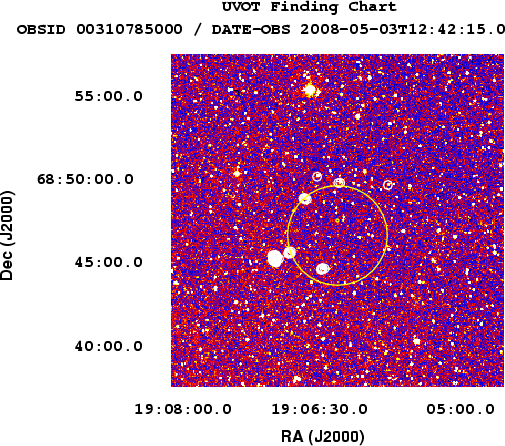
TITLE: GCN/SWIFT NOTICE
NOTICE_DATE: Sat 03 May 08 12:51:55 UT
NOTICE_TYPE: Swift-UVOT Image
TRIGGER_NUM: 5955576, Seg_Num: 66
POINT_RA: 0.000d {+00h 00m 00s} (J2000)
POINT_DEC: -214748.365d {-214748d 21' 52"} (J2000)
ROLL: -214748.365d
IMG_START_DATE: 30162 TJD; 15697 DOY; 08/135293677/137615576
IMG_START_TIME: 86165.00 SOD {23:56:05.00} UT, 41391.8 [sec] since BAT Trigger Time
FILTER: 0, illegal value
EXPOSURE_ID: 788549324
X_OFFSET: 0 [pixels]
Y_OFFSET: 68 [pixels]
WIDTH: 0 [pixels]
HEIGHT: 256 [pixels]
X_GRB_POS: 1728
Y_GRB_POS: 107
BINNING_INDEX: 2
IM_URL: sw00310785000msuni1345548591.fits
SUN_POSTN: 41.00d {+02h 43m 60s} +15.88d {+15d 52' 35"}
SUN_DIST: 133.42 [deg] Sun_angle= 2.7 [hr] (West of Sun)
MOON_POSTN: 13.03d {+00h 52m 08s} +9.86d {+09d 51' 33"}
MOON_DIST: 158.23 [deg]
MOON_ILLUM: 6 [%]
GAL_COORDS: 87.58, 67.63 [deg] galactic lon,lat of the pointing direction
ECL_COORDS: 356.65, 7.67 [deg] ecliptic lon,lat of the pointing direction
COMMENTS: SWIFT-UVOT Image.
COMMENTS: WARNING: This Notice was received with 1 (or more) critical values out of range.
COMMENTS: This Notice is generated as a result of an uploaded TOO on an old GRB -- this is not a newly detected burst.
COMMENTS: And the IMG_START_DATE/TIME fields are the current epoch -- not the original detection.
COMMENTS: The GRB Position came from the XRT Position Command.
COMMENTS: The image has 4x4 binning (compression).
COMMENTS: This notice was forced out after watchdog timer expiring -- most likely due to missing packet(s);
COMMENTS: as a consequence some of the fields may be incoorect (eg TRIGGER_NUM,RA,DEC).
TITLE: GCN/SWIFT NOTICE
NOTICE_DATE: Sat 03 May 08 12:52:18 UT
NOTICE_TYPE: Swift-UVOT Processed Image
TRIGGER_NUM: 5955576, Seg_Num: 66
POINT_RA: 0.000d {+00h 00m 00s} (J2000)
POINT_DEC: -214748.365d {-214748d 21' 52"} (J2000)
ROLL: -214748.365d
IMG_START_DATE: 30162 TJD; 15697 DOY; 08/135293677/137615576
IMG_START_TIME: 86165.00 SOD {23:56:05.00} UT, 41391.8 [sec] since BAT Trigger Time
FILTER: 0, illegal value
EXPOSURE_ID: 788549324
X_OFFSET: 0 [pixels]
Y_OFFSET: 68 [pixels]
WIDTH: 0 [pixels]
HEIGHT: 256 [pixels]
X_GRB_POS: 1728
Y_GRB_POS: 107
BINNING_INDEX: 2
IM_URL: sw00310785000msuni1345548591.fits
SUN_POSTN: 41.00d {+02h 43m 60s} +15.88d {+15d 52' 36"}
SUN_DIST: 133.42 [deg] Sun_angle= 2.7 [hr] (West of Sun)
MOON_POSTN: 13.04d {+00h 52m 09s} +9.86d {+09d 51' 39"}
MOON_DIST: 158.23 [deg]
MOON_ILLUM: 6 [%]
GAL_COORDS: 87.58, 67.63 [deg] galactic lon,lat of the pointing direction
ECL_COORDS: 356.65, 7.67 [deg] ecliptic lon,lat of the pointing direction
COMMENTS: SWIFT-UVOT Processed Image.
COMMENTS: WARNING: This Notice was received with 1 (or more) critical values out of range.
COMMENTS: This Notice is generated as a result of an uploaded TOO on an old GRB -- this is not a newly detected burst.
COMMENTS: And the IMG_START_DATE/TIME fields are the current epoch -- not the original detection.
COMMENTS: The GRB Position came from the XRT Position Command.
COMMENTS: The image has 4x4 binning (compression).
COMMENTS: If you have elected to receive attachments:
COMMENTS: The uvot_sources_image.fits.gz file does not exist; skipping the attachment.
COMMENTS: This notice was forced out after watchdog timer expiring -- most likely due to missing packet(s);
COMMENTS: as a consequence some of the fields may be incoorect (eg TRIGGER_NUM,RA,DEC).
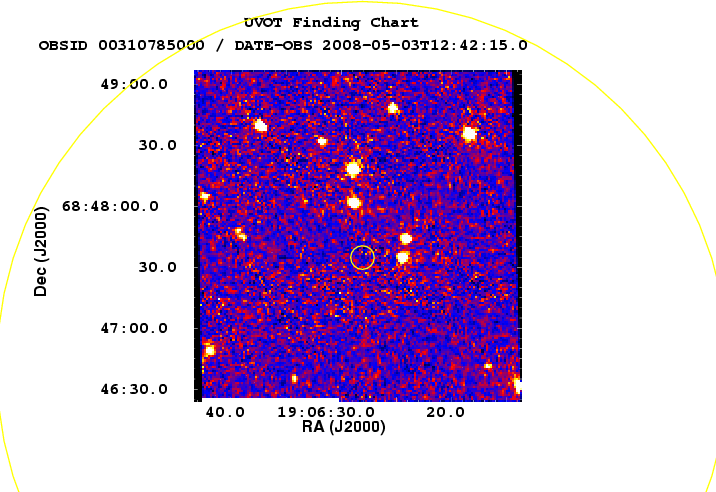
RA(J2000) = 19h 06m 28s Dec(J2000) = +68d 46' 41"with an uncertainty of 3 arcmin (radius, 90% containment, including systematic uncertainty). The BAT light curve showed a single spike structure with a duration of about 0.5 sec, although there may be further activity during the slew. The peak count rate was ~6500 counts/sec (15-350 keV), at ~0.1 sec after the trigger.
RA(J2000) = 19h 06m 28.92s Dec(J2000) = +68d 47' 37.6"with an uncertainty of 2.7 arcseconds (radius, 90% containment). This location is 57 arcseconds from the BAT onboard position, within the BAT error circle.
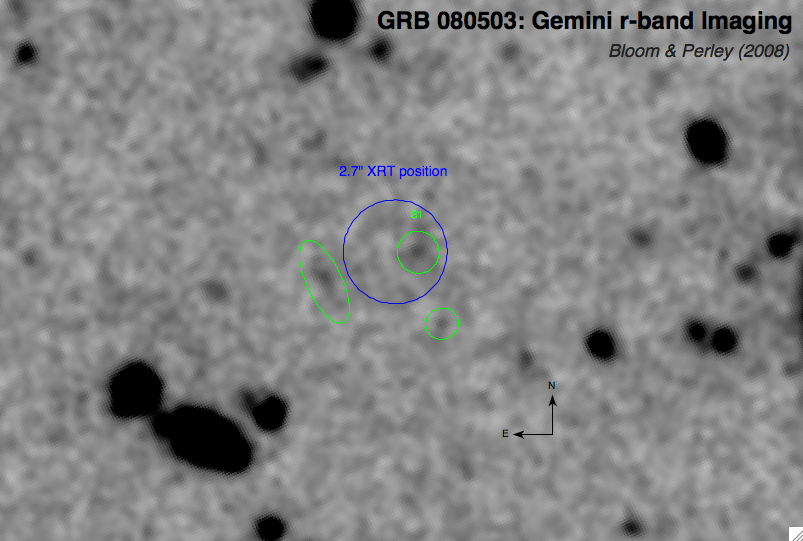
Filter start (UT) end (UT) Exposure LimitMag --------------------------------------------------- g' 12:31:53 12:41:03 9 x 60 s 18.8 Rc 12:31:53 12:41:03 9 x 60 s 19.2 Ic 12:31:53 12:41:03 9 x 60 s 18.1 ----------------------------------------------------
RA (J2000): 19h 06m 28.71s Dec (J2000): +68d 47' 35.9"with an uncertainty of 1.8 arcsec (radius, 90% confidence).
RA(J2000) = 19h 06m 44.7s Dec(J2000) = +68d 48' 09.2"with an uncertainty of 3.5 arcmin, (radius, sys+stat, 90% containment). The partial coding was 75%.
Filter T_start(s) T_stop(s) Exp(s) Mag UL (3sig) white 85 184 98 >20.0 white 85 12500 1314 >22.3 v 191 6749 1219 >20.5 b 671 11588 1203 >21.4 u 646 7365 471 >20.3 uvw1 622 7160 471 >20.4 uvm2 597 6954 471 >20.3 uvw2 701 13219 1133 >21.0The values quoted above are in the UVOT photometric system (Poole et al. 2008, MNRAS, 383, 627). They are not corrected for the expected Galactic extinction corresponding to a reddening of E(B-V)=0.06 mag in the direction of the burst (Schlegel et al. 1998).
Filter start (UT) end (UT) Exposure LimitMag --------------------------------------------------- g' 13:49:55 13:59:19 9 x 60 s 20.5 Rc 13:49:55 13:59:19 9 x 60 s 20.2 Ic 13:49:55 13:59:19 9 x 60 s 20.1 ----------------------------------------------------
Phase PLI Norm(@50keV) Chi2/DoF Initial 1.59 +/-0.28 (8.15 +- 1.5)E-3 69/59 Extended 1.91 +/-0.12 (1.19 +- 0.08)E-3 52/59The units of Normalization are ph/cm2/s/keV.
http://lyra.berkeley.edu/~jbloom/grb080503-comp.png http://lyra.berkeley.edu/~jbloom/grb080503-rebrightening.mpeg http://lyra.berkeley.edu/~dperley/080503/080503_s2b.pngWe report the following photometry, calibrated relative to USNO-B1.0:
Acquisition r-band image (t=0.98 hr) s1: R = 25.56 +/- 0.33 s2: R > 25.6 First night r-band stack (t=1.5 hr) s1: R = 26.00 +/- 0.18 s2: R >~ 26.5 Second night r-band stack (t=26.0 hr) s1: R = 25.70 +/- 0.12 s2: R = 25.28 +/- 0.09 UT_start exposure filter magnitude 13:23 1x180 r R = 24.8 +/- 0.3 13:38 1x30+2x300 R R > 25.5 (2-sigma) 13:47 5x180 r R = 25.4 +/- 0.2Photometric uncertainties do not include calibration uncertainties relative to USNO-B1.0, which are at the level of 0.1 magnitude. (This does not affect the relative magnitudes between the images).
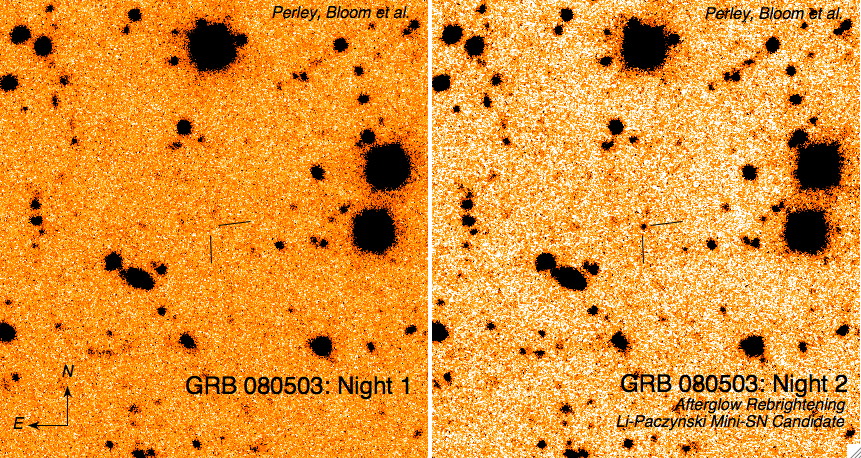
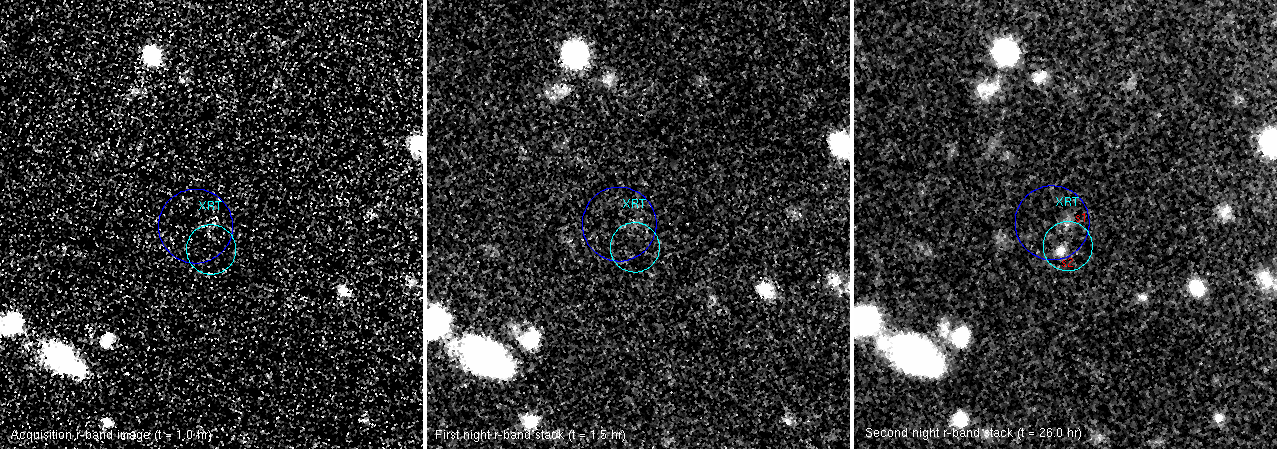
s1: R = 26.33 +/- 0.20 s2: R = 25.46 +/- 0.09This is consistent (within about 2-sigma) with the previous night's measurement and suggests neither additional rebrightening nor dramatic fading. We continue to strongly encourage follow-up with large-aperture instruments.
t(hr) magnitude 0.98 R > 25.6 1.5 R > 26.5 26.0 R = 25.28 +/- 0.09 47.4 R = 25.46 +/- 0.09Further observations are ongoing.
-------------------------------------------------------------- Start(UT) End(UT) Num. of frames Limit (mag.) -------------------------------------------------------------- 15:26:57 15:27:27 1 ~16.82 15:26:57 16:24:33 57 ~17.43 ---------------------------------------------------------------
F450W_AB = 26.95 +/- 0.27 F606W_AB = 26.86 +/- 0.15 F814W_AB > 26.6The nearby source s1 (see Perley et al., GCN 7667) is also detected, and appears visibly extended, though this extension does not reach s2. Two other faint, extended sources ("s3" and "s4") are detected about 1 arcsecond to the northwest and southeast of the transient, respectively. There is no obviously extended source detected at the position of s2.
